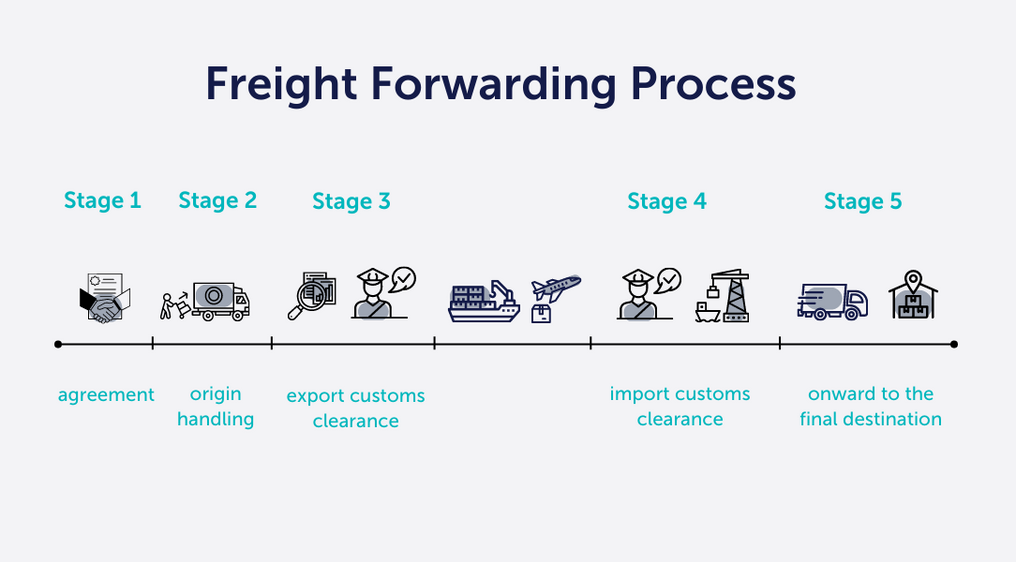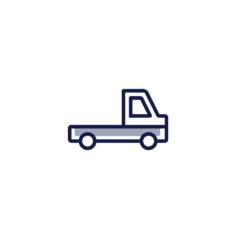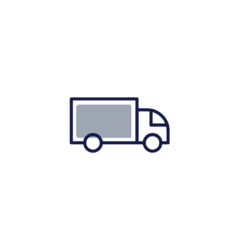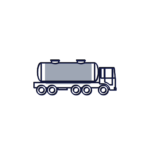What is freight forwarding? Everything you need to know

You will no doubt have heard the term freight forwarding – but what is it? Simply, freight forwarding is the process of moving imports and exports through the supply chain. Freight forwarding businesses work with shipping companies, airlines, hauliers, and customs authorities to move items from their point of origin to their final destination.
What is freight forwarding?
Freight forwarders organise the shipment of goods from one country to another. The goods may consist of packages, crates and containers, or a mixture of all three. They work for companies and individuals that import and export goods.
The client decides how much involvement the forwarder has in the goods’ journey. For example, it might be taking a container load from a factory in one country to another (for onward assembly), or it might contain finished goods that go from the producer directly to a shop’s warehousing facility. The freight forwarding company can use a mixture of shipping modes (not just ships!) but sea, aeroplanes, trucks and rail.
What is an example of freight forwarding?
Let’s say a factory in China manufactures children’s toys. The freight forwarding company could arrange to transport the toys from the factory to the Chinese airport by truck, fly the toys to London Heathrow, and then truck the toys from the airport to the customer’s warehouse or store in the UK.
Is freight forwarding the same as a 3PL?
A 3PL (Third Party Logistics) provider is capable of handling any part of your supply chain operations, whereas a freight forwarding company traditionally only handles the movement of goods.
For example, a 3PL can also offer value-added services such as, warehousing (including customs bonded warehousing), container storage and unloading, Kitting, assembly, and returns management. This is in addition to ‘goods in’ services, such as unloading goods, processing orders, pick and pack, courier transportation and delivery.
Learn more >> What is 3PL? A third-party logistics guide.
How freight forwarding works
Freight forwarding companies are intermediaries that utilise their ‘black book’ of trusted contacts to negotiate the best routes, and best rates, for companies that use their services. As well as being responsible for the movement of cargo, they also take responsibility for documentation and customs clearance.
Here’s the process in simple steps:
Stage one:
The importer and the supplier agree on terms of trade – known in the trade as International Commercial Terms (or ‘Incoterms.’) The Incoterms are a set of internationally recognised rules which define what each side is responsible for.
Stage two: origin handling and export clearance
Depending on the INCO terms agreed, the freight forwarding company can arrange to move the goods from the supplier’s location to the next part of the chain – whether that’s to a seaport, or an airport. The company will also arrange for the cargo to be satisfactorily inspected by the customs department of the origin country if required.
Stage three: export customs clearance
The freight forwarding company can be responsible for coordinating the relevant paperwork between the supplier and recipient of the goods to ensure that all laws and carrier requirements are met. In short, a passport for the shipment.
Stage four: import customs clearance
Once the cargo has arrived in its destination country, the paperwork must be checked once again to confirm that it meets the required custom and quarantine requirements. A good freight forwarding company will request and prepare this information in advance to reduce holdups in the process.
Step five: onward to the final destination
Once the goods are approved for release into the destination country, the freight forwarding company will organise its onward transit. This could be direct to the customer’s warehousing facility, retail store, or, if a 3PL is required, to a warehouse managed by the freight forwarder.
Types of freight forwarding
Freight forwarding companies may work with single or multiple carriers to ensure that the goods go from A to B safely and in a compliant manner. The carriers may use one or more modes of transportation, e.g. road haulage, air freight, and ocean freight.
Types of road haulage:
The freight forwarding company will decide which type of haulage vehicle is most suitable to carry the goods. The most common are articulated lorries (Artics) but there are other types of road transport that are specially designed to carry non-standard goods. For example:
Container truck
The standard and most cost-effective way to transport containers by road. Also includes curtain sided transportation: like the one pictured here – a container truck but with a durable soft side, which is ideal for loading and unloading goods quickly.
Flatbed, semi low loader, and low loader road transportation
Ideal for moving oversize construction equipment.
 Temperature controlled trucks – for transporting perishables, such as foodstuffs.
Temperature controlled trucks – for transporting perishables, such as foodstuffs.
Box trucks
Perfect for weather-sensitive cargo, such as clothes and perishable goods.
Car transportation
Specialist equipment with inbuilt ramps for ease of loading/unloading vehicles.
Tanker transportation
For the movement of liquids, chemicals and gases.
HIAB and side loaders
Known in the trade as a lorry mounted crane or lorry loader, a HIAB is used to load/unload trucks. May also be used in conjunction with a side loader, which provides a convenient way to load/unload shipping containers.
Types of air freight transportation
- Direct services: this is used typically for smaller parcels, where they can fit into the hold of an aircraft that is already taking a scheduled flight
- Consolidation: the most cost-effective air freight method; different shipments are placed in one flight. When using this service, freight forwarding companies need to be aware that this can delay transit times while waiting for the shipments to arrive.
- Charter: the most expensive option: the freight forwarding company charters an entire aircraft to carry specific cargo to the carrier’s exacting requirements.
Types of sea freight
When it comes to moving goods on the ocean, freight forwarding companies have to select from the most relevant type of vessel for their clients’ needs. These include:
- Container ships: the most common sight on the seas: container ships carry cargo packed into 20 or 40 foot containers, which are boxed on and below the deck. If the cargo does not fit neatly into the container, then other specialist equipment, such as flat racks, and open top versions, are available.
- Tankers: carrying liquids, gas, oil and other hazardous substances that require special care
- Breakbulk carriers: ideal for transporting single commodities such as coal, grain or fertilisers
- Roll-on/roll-off (roro) vessels: can transport anything that is typically wheeled onto it, such as large artics, smaller trucks, and passenger vehicles such as cars/vans/motorcycles
What does a freight forwarder do?
A freight forwarding company works on behalf of its customers to secure a seamless journey for the goods entrusted to them. There are always at least three elements involved: the manufacturer, the intermediary (freight forwarder) and the customer.
The freight forwarding company has key responsibilities:
- Safety and compliance – whoever loads the container is responsible for ensuring that the cargo is adequately packed and secured for its onward journey. This could be the job of either the shipper or the freight forwarder and this will be agreed beforehand.
- Speed & efficiency – ensuring goods arrive to the customer’s timelines
- Convenience – saving the client time by removing logistics coordination from their to do lists
Six great reasons to use a freight forwarder for your logistics
- Grow your business: the freight forwarding company takes all the hassle out of managing logistics so that customers can focus on growing their business. With a single point of contact for the entire supply chain and a consistent level of service, customers can invest more time and money into sales, manufacturing, product development and other value-adding activities.
- Better rates: freight forwarding companies are able to look after large shipment volumes, bundling up customers’ loads to take advantage of economies of scale. For example, a company wishing to import goods from China may not have enough to fill a full container, but by utilising LCL shipping (less than container load), the customer can reach their business requirements without the prohibitive costs.
- Simpler customs clearance: the best freight forwarding companies are AEO (Authorised Economic Operators). This means that they’re qualified to manage the various customs requirements required when moving freight through different locations. They may also be able to defer payment of import duties.
- Keep ahead of regulation: the freight forwarding partner stays aware of the trends and regulations impacting the industry and will ensure that customers are kept up to date.
- Expertise: freight forwarding companies build their reputation on taking care of all the intricacies of the logistics network. The best companies understand and share detailed information with their clients and partners to deliver the best service, for example: when ships are due to leave, import regulations and their country variations, as well as duty rates on specific products.
- Out of scope goods: freight forwarders offer information and advice on routes, origin, and how to handle special/unusual requirements including dangerous and hazardous goods.
International freight forwarding solutions from HFS
With an established presence close to Felixstowe and Liverpool, freight forwarding is where it all began for Hemisphere. Today, we have grown to become one of the country’s leading 3PL providers, but freight forwarding remains a cornerstone of our success.
We support imports and exports from countries such as China, the USA and Australia, via all UK ports, covering 900+ destinations worldwide. Whether you’re looking to move a single shipment or require a long term solution, we have been a trusted sea freight partner for over 33 years.
Please contact us to discuss your requirements.






